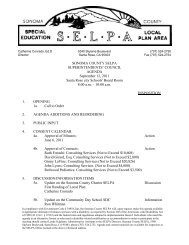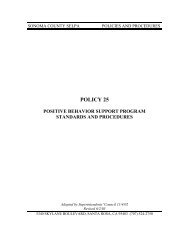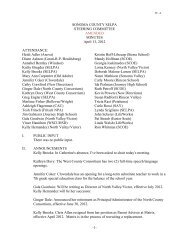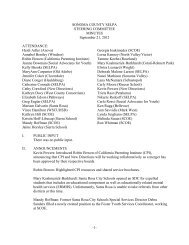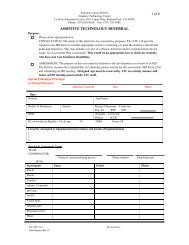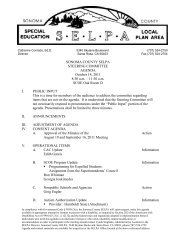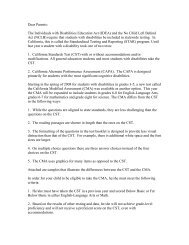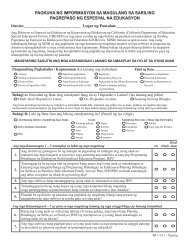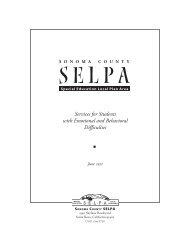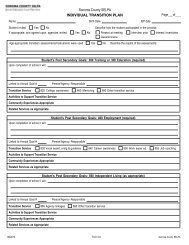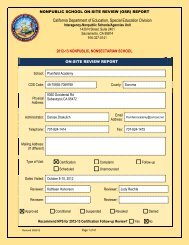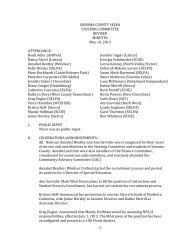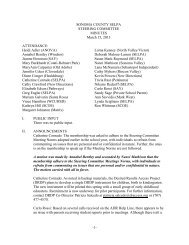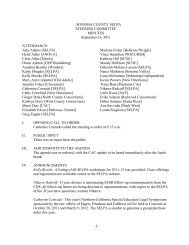Sonoma County SELPA Eligibility Criteria 9/12
Sonoma County SELPA Eligibility Criteria 9/12
Sonoma County SELPA Eligibility Criteria 9/12
Create successful ePaper yourself
Turn your PDF publications into a flip-book with our unique Google optimized e-Paper software.
SONOMA COUNTY <strong>SELPA</strong><br />
ELIGIBILITY CRITERIA OVERVIEW<br />
In order to qualify for special education and related services or, in other words, to be<br />
eligible under the Individuals with Disabilities Education Act (IDEA), a student must<br />
satisfy both parts of a two-part test. First, the student must be identified as an individual<br />
with exceptional needs, meeting the definition of one or more of the categories of<br />
disabilities specified under the IDEA. Second, the student must be shown to be in need<br />
of special education and related services as a result of his or her disability or disabilities.<br />
It must be noted that a student can demonstrate a disability, but not necessarily be eligible<br />
for special education and related services. <strong>Eligibility</strong> is determined by the IEP team,<br />
based on the requirement that eligibility conditions must “adversely affect educational<br />
performance.”<br />
The format for the individual disability categories is as follows:<br />
1. First, the federal IDEA disability criteria language for each category is given.<br />
2. Second, the California Education Code and/or Title 5 of the California Code<br />
of Regulations language are given.<br />
1
<strong>Eligibility</strong> <strong>Criteria</strong><br />
IDEA 34 CFR 300.7(c)(1)<br />
AUTISM<br />
Autism means a developmental disability significantly affecting verbal and nonverbal<br />
communication and social interaction, generally evident before age 3, that adversely<br />
affects a child's educational performance. Other characteristics often associated with<br />
autism are engagement in repetitive activities and stereotyped movements, resistance to<br />
environmental change or change in daily routines, and unusual responses to sensory<br />
experiences. The term does not apply if a child's educational performance is adversely<br />
affected primarily because the child has an emotional disturbance as defined in 34 CFR<br />
300.7(b).<br />
A child who manifests the characteristics of autism after age 3 could be diagnosed as<br />
having autism.<br />
California Administrative Code, Title 5, Section 3030(g)<br />
A pupil exhibits any combination (more than one) of the following autistic-like behaviors, to<br />
include but not be limited to:<br />
1. An inability to use oral language for appropriate communication.<br />
2. A history of extreme withdrawal or relating to people inappropriately and<br />
continued impairment in social interaction from infancy through early childhood.<br />
3. An obsession to maintain sameness.<br />
4. Extreme preoccupation with objects or inappropriate use of objects or both.<br />
5. Extreme resistance to controls.<br />
6. Displays peculiar motoric mannerisms and motility patterns.<br />
7. Self-stimulating, ritualistic behavior.<br />
2
DEAFNESS/HEARING IMPAIRMENT<br />
<strong>Eligibility</strong> <strong>Criteria</strong><br />
IDEA 34 CFR 300.7(c)(3) and (5)<br />
Deafness means a hearing impairment that is so severe that the child is impaired in processing<br />
linguistic information through hearing, with or without amplification, that adversely affects a<br />
child’s educational performance.<br />
Hearing impairment means an impairment in hearing, whether permanent or fluctuating, that<br />
adversely affects a child’s educational performance but that is not included under the<br />
definition of deafness in this section.<br />
California Administrative Code, Title 5. Section 3030(a)<br />
A pupil has a hearing impairment, whether permanent or fluctuating, which impairs the<br />
processing of linguistic information through hearing, even with amplification, and which<br />
adversely affects educational performance. Processing linguistic information includes speech<br />
and language reception and speech and language discrimination.<br />
3
DEAF-BLINDNESS<br />
<strong>Eligibility</strong> <strong>Criteria</strong><br />
IDEA 34 CFR 300.7(c)(2)<br />
Deaf-blindness means concomitant hearing and visual impairments, the combination of which<br />
causes such severe communication and other developmental and educational needs that they<br />
cannot be accommodated in programs solely for children with deafness or children with<br />
blindness.<br />
California Administrative Code, Title 5, Section 3030(b)<br />
A pupil has concomitant hearing and visual impairments, the combination of which causes<br />
severe communication, developmental, and educational problems.<br />
4
EMOTIONAL DISTURBANCE<br />
<strong>Eligibility</strong> <strong>Criteria</strong><br />
IDEA 34 CFR 300.7(c)(4)<br />
Emotional disturbance is defined as follows:<br />
The term means a condition exhibiting one or more of the following characteristics over a<br />
long period of time (two to nine months) and to a marked degree, that adversely affect a<br />
child's educational performance:<br />
1. An inability to learn that cannot be explained by intellectual, sensory, or health factors.<br />
2. An inability to build or maintain satisfactory interpersonal relationships with peers and<br />
teachers.<br />
3. Inappropriate types of behavior or feelings under normal circumstances<br />
4. A general pervasive mood of unhappiness or depression.<br />
5. A tendency to develop physical symptoms or fears associated with personal or school<br />
problems.<br />
The term includes schizophrenia. The term does not apply to children who are socially<br />
maladjusted, unless it is determined that they have an emotional disturbance.<br />
California Administrative Code, Title 5, Section 3030(i)<br />
Because of a serious emotional disturbance, a pupil exhibits one or more of the following<br />
characteristics over a long period of time (two to nine months) and to a marked degree, which<br />
adversely affect a child's educational performance:<br />
1. An inability to learn which cannot be explained by intellectual, sensory, or health<br />
factors.<br />
2. An inability to build or maintain satisfactory interpersonal relationships with peers and<br />
teachers.<br />
3. Inappropriate types of behavior or feelings under normal circumstances exhibited in<br />
several situations.<br />
4. A general pervasive mood of unhappiness or depression.<br />
5. A tendency to develop physical symptoms or fears associated with personal or school<br />
problems.<br />
5
INTELLECTUAL DISABILITY<br />
<strong>Eligibility</strong> <strong>Criteria</strong><br />
IDEA 34 CFR 300.7(c)(6)<br />
Mental retardation means significantly subaverage general intellectual functioning, existing<br />
concurrently with deficits in adaptive behavior and manifested during the developmental<br />
period, that adversely affect a child's educational performance.<br />
California Administrative Code, Title 5, Section 3030(h)<br />
A pupil has significantly below average general intellectual functioning existing concurrently<br />
with deficits in adaptive behavior and manifested during the developmental period, which<br />
adversely affect educational performance.<br />
6
MULTIPLE DISABILITY<br />
<strong>Eligibility</strong> <strong>Criteria</strong><br />
IDEA 34 CFR 300.7(c)(7)<br />
Multiple disabilities means concomitant impairments (such as intellectual disability-blindness,<br />
intellectual disability-orthopedic impairment, etc.), the combination of which causes such<br />
severe educational needs that they cannot be accommodated in special education programs<br />
solely for one of the impairments. The term does not include deaf-blindness.<br />
Note: There is no California statute or regulation that defines multiple disabilities.<br />
<strong>SELPA</strong> Guidelines<br />
This category is not included as a disability in California statute or regulations, and is rarely<br />
applied. The <strong>Sonoma</strong> <strong>County</strong> <strong>SELPA</strong> generally advises that students, when possible, be<br />
identified by the low incidence category that applies accurately to that particular student<br />
(Hearing Impairment, Visual Impairment, Orthopedic Impairment), as this allows for special<br />
funding.<br />
7
ORTHOPEDIC IMPAIRMENT<br />
<strong>Eligibility</strong> <strong>Criteria</strong><br />
IDEA 34 CFR 300.7(c)(8)<br />
Orthopedic impairment means a severe orthopedic impairment that adversely affects a child’s<br />
educational performance. The term includes impairments caused by congenital anomaly (e.g.,<br />
clubfoot, absence of some member, etc.), impairments caused by disease (e.g., poliomyelitis,<br />
bone tuberculosis, etc.), and impairments from other causes (e.g., cerebral palsy, amputations<br />
and fractures or burns that cause contractures.)<br />
California Administrative Code, Title 5, Section 3030(e)<br />
A pupil has a severe orthopedic impairment which affects a child’s educational performance.<br />
Such orthopedic impairments include impairments caused by congenital anomaly,<br />
impairments caused by disease, and impairments from other causes.<br />
8
<strong>Eligibility</strong> <strong>Criteria</strong><br />
IDEA 34 CFR 300.7(c)(9)<br />
OTHER HEALTH IMPAIRMENT<br />
Other health impairment means having limited strength, vitality or alertness, including a<br />
heightened alertness to environmental stimuli, that results in limited alertness with respect to<br />
the educational environment, that:<br />
1. Is due to chronic or acute health problems such as asthma, attention deficit<br />
disorder or attention deficit hyperactivity disorder, diabetes, epilepsy, a heart<br />
condition, hemophilia, lead poisoning, leukemia, nephritis, rheumatic fever, and<br />
sickle cell anemia; and<br />
2. Adversely affects the student's educational performance.<br />
California Administrative Code, Title 5, Section 3030(f)<br />
A pupil has limited strength, vitality, or alertness, due to chronic or acute health problems,<br />
including but not limited to a heart condition, cancer, leukemia, rheumatic fever, chronic<br />
kidney disease, cystic fibrosis, severe asthma, epilepsy, lead poisoning, diabetes, tuberculosis<br />
and other communicable infectious diseases, and hematological disorders such as sickle cell<br />
anemia and hemophilia, which adversely affects a pupil's educational performance. Such<br />
physical disabilities shall not be temporary in nature. In accordance with Section 56026(e) of<br />
the Education Code, such physical disabilities shall not be temporary in nature as defined by<br />
Section 3001(ag)).<br />
California Administrative Code, Title 5, Section 3001 (ag)<br />
Temporary physical disability" means a disability incurred while an individual was in a<br />
regular education class and which at the termination of the temporary physical disability, the<br />
individual can, without special intervention, reasonably be expected to return to his or her<br />
regular education class.<br />
9
<strong>Eligibility</strong> <strong>Criteria</strong><br />
IDEA 34 CFR 300.7(c)(10)<br />
SPECIFIC LEARNING DISABILITY<br />
The term means a disorder in one or more of the basic psychological processes involved in<br />
understanding or in using language, spoken or written, that may manifest itself in an imperfect<br />
ability to listen, think, speak, read, write, spell, or do mathematical calculations, including<br />
conditions such as perceptual disabilities, brain injury, minimal brain dysfunction, dyslexia<br />
and developmental aphasia.<br />
The term does not include learning problems that are primarily the result of visual, hearing or<br />
motor disabilities, of intellectual disability, of emotional disturbance, or of environmental,<br />
cultural or economic disadvantage.<br />
IDEA 34 CFR 300.309(a)<br />
The student’s IEP team may determine the student may determine that a child has a specific<br />
learning disability, as defined in § 300.8(c)(10), if--<br />
(1) The child does not achieve adequately for the child's age or to meet State-approved<br />
grade-level standards in one or more of the following areas, when provided with learning<br />
experiences and instruction appropriate for the child's age or State-approved grade-level<br />
standards:<br />
(i) Oral expression.<br />
(ii) Listening comprehension.<br />
(iii) Written expression.<br />
(iv) Basic reading skill.<br />
(v) Reading fluency skills.<br />
(vi) Reading comprehension.<br />
(vii) Mathematics calculation.<br />
(viii) Mathematics problem solving.<br />
RTI<br />
(2)(i) The child does not make sufficient progress to meet age or State-approved gradelevel<br />
standards in one or more of the areas identified in paragraph (1) of this section when<br />
using a process based on the child's response to scientific, research-based intervention;<br />
Or<br />
Severe Discrepancy<br />
(ii) The child exhibits a pattern of strengths and weaknesses in performance,<br />
achievement, or both, relative to age, State-approved grade-level standards, or intellectual<br />
development, that is determined by the group to be relevant to the identification of a<br />
specific learning disability, using appropriate assessments, consistent with §§ 300.304<br />
and 300.305; and<br />
10
(3) The group determines that its findings under paragraphs (1) and (2) of this section are<br />
not primarily the result of--<br />
(i) A visual, hearing, or motor disability;<br />
(ii) Mental retardation;<br />
(iii) Emotional disturbance;<br />
(iv) Cultural factors;<br />
(v) Environmental or economic disadvantage; or<br />
(vi) Limited English proficiency.<br />
Education Code Section 56337<br />
A pupil shall be assessed as having a specific learning disability which makes him or her<br />
eligible for special education and related services when it is determined that all of the<br />
following exist:<br />
a. A severe discrepancy exists between the intellectual ability and achievement in one or<br />
more of the following academic areas:<br />
1. Oral Expression<br />
2. Listening Comprehension<br />
3. Written Expression<br />
4. Basic Reading Skills<br />
5. Reading Comprehension<br />
6. Mathematics Calculation<br />
7. Mathematics Reasoning<br />
b. The discrepancy is due to a disorder in one or more of the basic psychological processes<br />
and is not the result of environmental, cultural, or economic disadvantages.<br />
c. The discrepancy cannot be corrected through other regular or categorical services offered<br />
within the regular instructional programs.<br />
California Administrative Code, Title 5, Section 3030(j)<br />
A pupil has a disorder in one or more of the basic psychological processes involved in<br />
understanding or in using language, spoken or written, which may manifest itself in an<br />
impaired ability to listen, think, speak, read, write, spell or do mathematical calculations, and<br />
has a severe discrepancy between intellectual ability and achievement in one or more of the<br />
academic areas specified in Section 56337(a) of the Education Code.<br />
For the purpose of Section 3030(j):<br />
11
1) Basic psychological processes include attention, visual processing, auditory<br />
processing, sensory-motor skills, and cognitive abilities including association,<br />
conceptualization and expression.<br />
2) Intellectual ability includes both acquired learning and learning potential and shall be<br />
determined by a systematic assessment of intellectual functioning.<br />
3) The level of achievement includes the student's level of competence in materials and<br />
subject matter explicitly taught in school and shall be measured by standardized<br />
achievement tests.<br />
4) The decision as to whether or not a severe discrepancy exists shall be made by the<br />
individualized education program team, including assessment personnel in accordance<br />
with Section 56341 (d), which takes into account all relevant material which is<br />
available on the pupil. No single score or product of scores, test, or procedure shall be<br />
used as the sole criterion for the decisions of the individualized education program<br />
team as to the pupil's eligibility for special education.<br />
In determining the existence of a severe discrepancy, the individualized education<br />
program team shall use the following procedures:<br />
A. When standardized tests are considered to be valid for a specific pupil, a<br />
severe discrepancy is demonstrated by: first, converting into common<br />
standard scores, using a mean of 100 and standard deviation of 15, the<br />
achievement test score and the ability test score to be compared; second,<br />
computing the difference between these common standard scores and third,<br />
comparing this computed difference to the standard criterion which is the<br />
product of 1.5 multiplied by the standard deviation of the distribution of<br />
computed differences of students taking these achievement and ability tests. A<br />
computed difference which equals or exceeds this standard criterion, adjusted<br />
by one standard error of measurement, the adjustment not to exceed 4<br />
common standard score points, indicates a severe discrepancy when such<br />
discrepancy is corroborated by other assessment data which may include other<br />
tests, scales, instruments, observations and work samples, as appropriate.<br />
B. When standardized tests are considered to be invalid for a specific pupil, the<br />
discrepancy shall be measured by alternative means as specified on the<br />
assessment plan.<br />
C. If the standardized tests do not reveal a severe discrepancy as defined in<br />
subparagraphs (A) or (B) above, the individualized education program team<br />
may find that a severe discrepancy does exist, provided that the team<br />
documents in a written report that the severe discrepancy between ability and<br />
achievement exists as a result of a disorder in one or more of the basic<br />
psychological processes. The report shall include a statement of the area, the<br />
degree, and the basis and method used in determining the discrepancy. The<br />
<strong>12</strong>
eport shall contain information considered by the team which shall include,<br />
but not be limited to:<br />
1. Data obtained from standardized assessment instruments;<br />
2. Information provided by the parent;<br />
3. Information provided by the pupil's present teacher;<br />
4. Evidence of the pupil's performance in the regular and/or special<br />
education classroom obtained from observations, work samples, and<br />
group test scores;<br />
5. Consideration of the pupil's age, particularly for young children; and<br />
6. Any additional relevant information.<br />
5) The discrepancy shall not be primarily the result of limited school experience or<br />
poor school attendance.<br />
13
<strong>Eligibility</strong> <strong>Criteria</strong><br />
SPEECH OR LANGUAGE IMPAIRMENT<br />
IDEA 34 CFR 300.7(c)(11)<br />
Speech or language impairment means a communication disorder, such as stuttering,<br />
impaired articulation, a language impairment, or a voice impairment, that adversely<br />
affects a child’s educational performance.<br />
California Education Code Section 56333<br />
A pupil shall be assessed as having a language or speech disorder which makes him or<br />
her eligible for special education and related services when he or she demonstrates<br />
difficulty understanding or using spoken language to such an extent that it adversely<br />
affects his or her educational performance and cannot be corrected without special<br />
education and related services. In order to be eligible for special education and related<br />
services, difficulty in understanding or using spoken language shall be assessed by a<br />
language, speech, and hearing specialist who determines that such difficulty results from<br />
any of the following disorders:<br />
(a) Articulation disorders, such that the pupil’s production of speech significantly<br />
interferes with communication and attracts adverse attention.<br />
(b) Abnormal voice, characterized by persistent, defective voice quality, pitch, or<br />
loudness. An appropriate medical examination shall be conducted, where appropriate.<br />
(c) Fluency difficulties which result in an abnormal flow of verbal expression to such<br />
a degree that these difficulties adversely affect communication between the pupil and<br />
listener.<br />
(d) Inappropriate or inadequate acquisition, comprehension, or expression of spoken<br />
language such that the pupil’s language performance level is significantly below the<br />
language performance level of his or her peers.<br />
(e) Hearing loss which results in a language or speech disorder and significantly<br />
affects educational performance.<br />
California Code of Regulations, Title 5, Section 3030(c)<br />
(c)<br />
A pupil has a language or speech disorder as defined in Section 56333 of the<br />
Education code, and it is determined that the pupil’s disorder meets one or<br />
more of the following criteria:<br />
(1) Articulation disorder.<br />
(A) The pupil displays reduced intelligibility or an inability to use the<br />
speech mechanism, which significantly interferes with<br />
communication and attracts adverse attention. Significant<br />
interference occurs when the pupil’s production of multiple speech<br />
sounds on a developmental scale of articulation competency is<br />
below that expected for his or her chronological age or<br />
14
development level, and which adversely affects educational<br />
performance.<br />
(B)<br />
A pupil does not meet the criteria for an articulation disorder if the<br />
sole assessed disability is an abnormal swallowing pattern.<br />
(2) Abnormal Voice .<br />
A pupil has an abnormal voice which is characterized by persistent<br />
defective voice quality, pitch, or loudness.<br />
(3) Fluency Disorders.<br />
A pupil has a fluency disorder when the flow of verbal expression,<br />
including rate and rhythm, adversely affects communication between the<br />
pupil and listener.<br />
(4) Language Disorder.<br />
A pupil has a language disorder when he or she meets one or more of the<br />
following criteria:<br />
(A)<br />
The pupil scores at least 1.5 standard deviations below the mean,<br />
or below the 7 th percentile, for his or her chronological age or<br />
developmental level on two or more standardized tests in one or<br />
more of the following areas of language development:<br />
morphology, syntax, semantics, or pragmatics. When standardized<br />
tests are considered to be invalid for the specific pupil, the<br />
expected language performance level shall be determined by<br />
alternative means as specified on the assessment plan,<br />
or<br />
(B)<br />
The pupil scores at least 1.5 standard deviations below the mean or<br />
the score is below the 7 th percentile for his or her chronological age<br />
or developmental level on one or more standardized tests in one of<br />
the areas listed in subsection (A) and displays inappropriate or<br />
inadequate usage of expressive or receptive language sample of a<br />
minimum of fifty utterances. The language sample must be<br />
recorded or transcribed and analyzed, and the results included in<br />
the assessment report. If the pupil is unable to produce this<br />
sample, the language, speech, and hearing specialist shall<br />
document why a fifty utterance sample was not obtainable and the<br />
contexts in which attempts were made to elicit the sample. When<br />
standardized tests are considered to be invalid for the specific<br />
pupil, the expected language performance level shall be<br />
determined by alternative means as specified in the assessment<br />
plan.<br />
15
TRAUMATIC BRAIN INJURY<br />
<strong>Eligibility</strong> <strong>Criteria</strong><br />
IDEA 34 CFR 300.7(c)(<strong>12</strong>)<br />
Traumatic brain injury means an acquired injury to the brain caused by an external physical<br />
force, resulting in total or partial functional disability or psychosocial impairment, or both, that<br />
adversely affects the student's educational performance. The term applies to open or closed<br />
head injuries resulting in impairments in one or more areas, such as cognition; language;<br />
memory; attention; reasoning; abstract thinking; judgment; problem solving; sensory,<br />
perceptual, and motor abilities; psychosocial behavior; physical functions; information<br />
processing; and speech. The term does not apply to brain injuries that are congenital or<br />
degenerative, or to brain injuries induced by birth trauma.<br />
Note: There is no California statute or regulation that defines Traumatic Brain Injury.<br />
16
VISUAL IMPAIRMENT<br />
<strong>Eligibility</strong> <strong>Criteria</strong><br />
IDEA 34 CFR 300.7 (c) (13)<br />
Visual impairment including blindness means an impairment in vision that, even with<br />
correction, adversely affects a child's educational performance. The term includes both partial<br />
sight and blindness.<br />
California Administrative Code, Title 5, Section 3030 (d)<br />
A pupil has a visual impairment, which, even with correction, adversely affects a pupil’s<br />
educational performance.<br />
17



